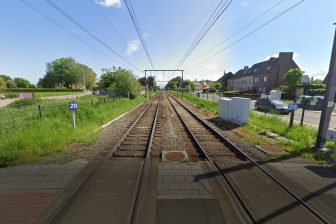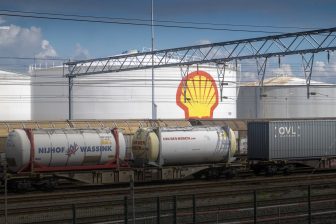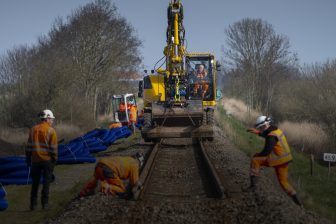UIC ERTMS world conference 2007
750 participants from all over the world gather to in Bern to share experience on the development and roll-out of ERTMS
Paris, France – From the beginning, the Swiss have been at the very forefront of the
implementation of ERTMS,” said Michael Clausecker, Director General of the European Railway Industries (UNIFE) at the opening 2007-09-11 in Bern of UIC’s World Conference on Europe’s Rail Traffic Management System – known as ERTMS.
Luc Aliadière, Chief Executive of the International Union of Railways (UIC ) main organizer of the conference concurred and said “The location of the Conference in Switzerland has special significance as it is a very suitable venue to demonstrate the advances that have been made in ERTMS and also to discuss the theme of our Conference – From independent Networks to Interoperability.”
The UIC World Conference on ERTMS has brought together over 750 participants from all around the globe. In the coming days, representatives of the European Union, government officials, rail operators and the rail supply industry (signalling and telecommunications), will debate and share experiences on the deployment of ERTMS – the aim being – to have a global overview of all new ERTMS components. The components of ERTMS are ETCS (unified signalisation – train control command system) and GSM-R (radio communications system), currently in operation in Europe and various parts of the world.
This leading international conference has been organised in close cooperation between UIC, the Swiss Federal Railways SBB, BLS AG, the Swiss Federal Office of Transport and UNIFE, and is supported by other associations from the rail sector such as CER and EIM together with the ERTMS Users Group and GSM-R Industry Group.
“This morning participants had the opportunity to make a test trip on board an ICN train on the stretch of new line from Mattstetten – Rothrist and then through the Lötschberg base tunnel for a demonstration of ETCS Level 2 with live video showing ETCS in Switzerland. Switzerland offers a notable example of how ERTMS has been successfully integrated into national transport plans and ERTMS [ETCS and GSM-R] will provide Switzerland with the capability to meet the strong domestic and international growth forecast for rail in the coming decades,” said Mr. Clausecker.
The Opening Ceremony took place with the presence of Moritz Leuenberger, Swiss Minister of Transport, Max Friedli, Director of the Swiss Federal Office of Transport,
Luc Aliadière, Chief Executive of UIC, Michael Clausecker, Director General of UNIFE, Ola Bergmann, Chairman of GSM-R Industry Group. In the presence of Andreas Meyer, CEO of SBB, Mathias Tromp, CEO of BLS, Karel Vinck, Coordinator of the European Commission for ERTMS, Marcel Verslype, Executive Director, and Pio Guido, Head of ERTMS Unit of the European Railway Agency (ERA), and Vipin Sharma, Deputy Chief Executive, responsible for the UIC global dimension, Roland Heinisch, DB, current Chairman of the UIC ERTMS Platform and Michele Elia, Chief Executive RFI, and future Chairman of UIC ERTMS Platform, Hansjörg Hess, Head of Infrastructure of SBB and future Vice-Chairman of UIC ERTMS. Tom Harris MP, the Parliamentary under-secretary at the UK’s Department for Transport came especially to Bern for the technical visit.
ERTMS/ETCS/GSM-R is a major project for the future of railways. The unified signalisation / train control command system, ETCS and radio communications system and GSM-R are all vital in the development and rollout of ERTMS and the related implementation of ETCS and GSM-R are both a major investment for all the railway companies,” said Mr. Aliadière.
The introduction of common technology for a unified signalling system, and more generally, unified European standard equipment (interlocking, ETCS, GSM-R) and the related standard interfaces, should lead to worthwhile results. These results include: the enhancement of railway network efficiency as a whole by increasing line capacity and improving safety, improved interoperability especially on international corridors, simplification of cross-border transport services with direct trains, cost savings resulting from use of less expensive train control systems, technologies, infrastructure and vehicles, at least in the long term (harmonisation, standardisation, competition, production quantities).
Implementation status of ETCS and GSM-R
The joint efforts of the railways (infrastructure managers and operators) and manufacturing industry to promote ERTMS, under the leadership of the European Union, are now resulting in increasing practical success. After long on studies specification development, testing and pilot applications, the rollout has now begun, on both high-speed and conventional lines with mixed traffic. Full revenue service has begun on several lines ETCS is being deployed nationally on specific routes, a first step to aligning with other national plans along specific international corridors, in accordance with the European MoU six-corridor strategy.
Today, more than 2’000 km of lines are in commercial operation in ETCS level 1 and level 2 and almost 20’000 have been contracted or planned in the coming 10 years. From a rolling stock point of view, 852 units are in commercial operation on the ETCS network, 275 are going to be purchased and 484 will be retrofitted.*
GSM-R has been generally deployed on a national basis, in many cases, to replace the old analogue systems and it will also be used to bear the ETCS data in the level 2 and 3 applications, when ETCS is deployed.
2007 is an important year for GSM-R in Europe, with the first case of full migration in the Netherlands. By the end of 2007 Italy, Germany, Norway and Sweden will have migrated or taken the first step towards migration. This will mean that 47,700 km of railway will eventually have been migrated.
Also, on a global level, the railways are taking advantage of the development of unified systems. Over two thousand lines have been contracted in China, India, Mexico, Saudi Arabia, South Korea and Taiwan and Australia has installed a pilot project.
We are sure that this conference will be very fruitful for the further balanced development of ERTMS. More information will follow at the conclusions of the Conference.
Additional background information (provided by Infrasite’s Editorial Staff)
Lotschberg base tunnel project complete (2007-06-15)
Second annual reports Trans-European transport network (2007-09-11)
U las zojuist één van de gratis premium artikelen
Onbeperkt lezen? Profiteer nu van de introductieaanbieding voor € 10,- per maand.
Bent u al abonnee?



